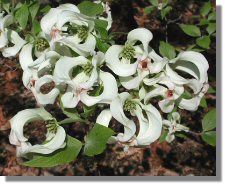This is the perfect time of year to cut branches of shrubs and trees for forcing. The buds for spring flowering shrubs and trees develop during the previous year. They require six weeks of cold weather before their dormancy can be successfully broken
by forcing. With the winter we have had this year, we have already had more than 6 weeks of sufficiently cold weather.
In its simplest form, forcing is just a matter of cutting bare branches from the desired shrub or tree and placing them in water indoors. There are a few tips for insuring success, though. First look for plump buds for cutting. The more developed the
buds, the more quickly they will develop indoors. Use pruning shears or a sharp knife to cut the branches and carefully split the cut end 2 to 4 inches. Remove any buds and twigs that will be under water. Then place the branch in warm water and recut one-half to one inch
off the stem. Do not expose the cut branch to air again. All of this will aid water absorption by the branch, which is essential for the flowers to develop. Place the vase of branches in a dimly lighted location (away from a bright window) with a temperature of 60 to 70
days. Change the water every few days to minimize bacteria development. If you have to expose the branches to air when changing the water, recut the ends of the stems under water again, as described above.
One more tip on cutting branches - always cut the shrub or tree with an eye towards the symmetry and desired size of the plant. You have to live with this plant all year long and you want it to be attractive. Some people who want to force a lot of
branches in winter and early spring plant shrubs and trees specifically for that purpose in hidden away places. Then they do not have to worry about shape, although they do have to be aware that over-pruning can kill the specimen.
It can take anywhere from 1 to 8 weeks for flowers to develop. The fatter the buds and the closer to their natural bloom time that you cut the branches, the sooner they will open. Forsythia, quince and pussywillow branches generally take only 1 to 3
weeks to force, because they are among the earliest blooming shrubs. For apple, dogwood, peach, plum and lilac, you should wait until the middle of March before cutting them and bringing them indoors to force for blooms.
|

Cornus florida |
Some of the most common shrubs and trees used for forcing include of course the pussywillow, forsythia and Japanese or flowering quince. Others to consider are redbud trees, flowering dogwood (Cornus florida), hawthorn, witch hazel, saucer magnolia,
star magnolia, apple and crabapple, flowering cherry, spirea, fothergilla, and lilac.
Do not limit yourself to flowering shrubs and trees when you think of forcing. Ordinary non-flowering trees and shrubs can also be forced, to interesting effect. Bittersweet is one of the more sculptural twigs to force. Red maples create bright
scarlet buds along their gray branches. Birch trees produce long, fuzzy catkins flowed by tiny new bright green leaves. Weeping willow branches make wonderfully drooping chartreuse switches.
Have fun on these dreary winter days and force a mixture of flowering and non flowering branches in creative arrangements.
Read other articles about tree care